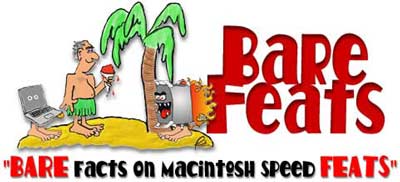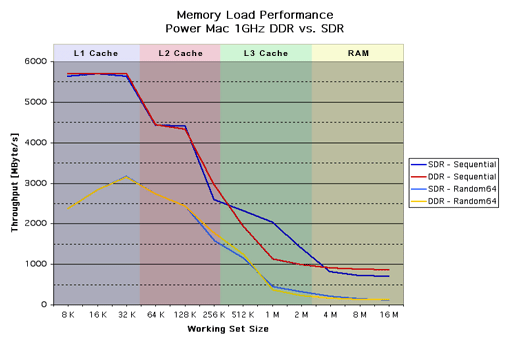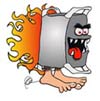

SmallDog.com
has refurbished
towers, laptops, displays, etc., with 12 month
warranty.
"Old" SDRAM version |
||||||||||||||||||||||||||||||||||||||||||||||||||||||||||||||||
|
Originally
posted 8/15/02 by rob-ART morgan, mad scientist (Note to skeptics that doubted Greg's DDR results: On 8/26/02 we re-ran every test in the Bare Feats local lab using a different DDR 1GHz/MP Power Mac with even more memory (1.25GB) and got the same results as he got. This report is not a mistake, not a fake, and not a fluke as some suggested.) Does the new 2.7GB/s DDR memory bus and 167MHz system bus make a difference? Has we taken a leap forward in Power Macs overall system throughput? I figured the best way to tell is to run the NEW DDR Dual 1GHz Power Mac against the "obsolete" SDR (short for SDRAM) Dual 1GHz Power Mac (and the DDR based Xserve Dual 1GHz).

CONCLUSION To my surprise and chagrin, the new Power Mac with DDR RAM has no performance advantage over the old SDR Power Mac running at the same clock speed. The 25% faster system bus seems of no help, either. Depressing. Scandalous! FOR MORE TEST RESULTS THAT STRESS THE DISK AND GRAPHICS SUBSYSTEMS, TURN TO PAGE TWO. 10/20/02 -- MacAddict published their own shootout between a DDR 1GHz G4 and an SDR 1GHz G4. They showed a significant difference in speed but I believe their tests are faulty. All three tests involve the hard drive. Their two test machines had a different model of hard drive. Therefore, the results should be different. In the BARE FEATS tests, I used the same 120GXP hard drive in both machines. The results were virtually identical. Where's the bottleneck? Here are some theories from readers on why the new DDR machine isn't any faster: 1. The two processors share a 1.3GB/s pipe to Apple's custom AGP/Memory controller. So the 2.7GB/s memory gets "starved." Here's a very interesting graph created with data generated by an app named MemPerf written by Basil Achermann. It reveals what's going on with L1 cache, L2 cache, L3 cache, and regular RAM: 
The graph above shows that the SDR Mac is as much as 81% faster for several sequential 0.5-2MB data accesses over the same data or whenever its larger L3 cache is used a lot. The DDR Mac can load 21% faster from the main memory but only because of the 25% faster bus speed, not because of the doubled data rate (proof for the bottleneck). Real world applications use both L3 cache and RAM, and that's why they all score about the same on both machines. What will it take to fix the bottleneck? 1. A CPU than can handle the full speed of DDR memory (like the fabled PPC 7470). Will the Dual 1.25GHz Power Mac be 25% faster as the specs imply? Will it smoke the Pentium 4 2.53GHz system as Apple claims? We plan to answer those and other questions in about 6 weeks... when the top model ships. Meanwhile, we have already started testing on the Pentium 4 2.53GHz system. Here's a chart comparing the features and specs of the three Dual 1GHz systems: CPU
Clock Speed System
Bus Speed Memory
Bus Speed Maximum
Memory L3
Cache L3 Cache
Throughput Standard
Graphics Card Optional
Graphics ATA
drive bus speed ATA
drive connections full
length PCI slots PCI bus
speed FireWire
Ports Gigabit
Ethernet Ports Price
for Dual 1GHz Base Model * Combo PCI/AGP short slot can be used for short AGP graphics card or Gigabit Ethernet card but for both. Full length GeForce4 Titanium won't fit. And you'll need a special AGP riser for the short card if you decide to upgrade. The default factory config is a generic ATI PCI graphics card which seems to be on the level of a Radeon 7000. ** The Power Mac G4/1.25GHz MP will ship with 2MB L3 per CPU
RELATED LINKS Apple has published some test results of their own using Photoshop, Final Cut Pro, and DVD encloding (iDVD?). You can download the Technical Overview PDF with these results. They haven't responded yet to my request for details as to how these tests were run so we can't duplicate or verify the results. PowerLogix published an in-depth white paper discussion (PDF ) comparing single data rate static RAM ("SDR") architecture versus double data rate ("DDR") when designing the level 3 cache circuitry for use with the latest Motorola G4/745x processors. Don't forget to TURN TO PAGE TWO and THREE for more DDR vs SDR test results. If you buy a new DDR Power Mac, make sure you specify DDR PC2700 333MHz (Non ECC) 64x64 CL2.5 memory. I found the 512MB modules at Data Memory Systems for $135 (part number DM50 609). Check also with TransIntl.com but be sure to specify "PC2700" since they don't list the speed on their website.
TEST NOTES The "SDR" Power
Mac 1GHz MP had 1GB of PC133 CL2 SDRAM. For details on each real world test, read "HOW I TEST." |
HOME PAGE
SPEED TEST RESULTS by Category
LINKS to SPEED tests on other sites
HOT DEALS on speed upgrades
rob-ART
morgan,
mad scientist and webmaster

Has Bare Feats helped you? Say "thanks"... with a donation.
"BARE facts on Macintosh speed FEATS"
Email webmaster at rob-art@barefeats.com
(Bare Feats is hosted on a G4 Power Mac server by MacDock.com)




